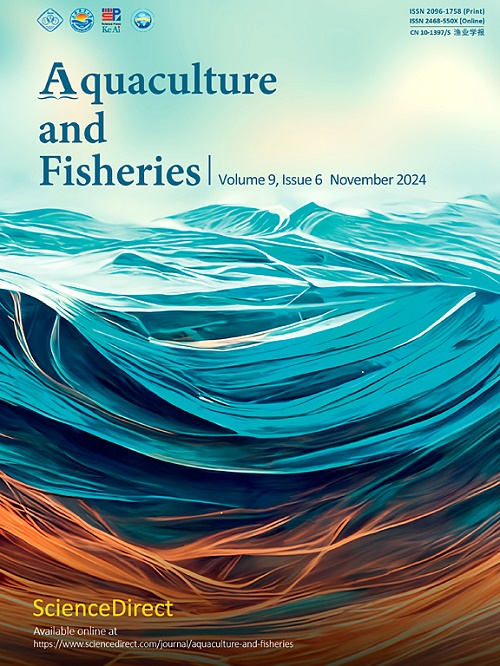微生物源抗氧化剂对氨氮胁迫下中华鳖肝胰腺的生长、消化酶和转氨酶活性以及抗氧化能力的影响
Q1 Agricultural and Biological Sciences
引用次数: 0
摘要
本研究评估了投喂微生物源抗氧化饲料(MA)56天对中华绒螯蟹生长性能的影响,以及在氨胁迫(400 mg/L氨氮,48 h)条件下对消化代谢酶活性和抗氧化能力的影响。MA组螃蟹28 d的增重和56 d的特定生长率显著高于对照组(P <0.05)。与 C 组相比,MA 组的肝胰脏颜色明显改善(p < 0.05)。微生物抗氧化氨-N(MA_A)组的血淋巴氨水平明显下降(p <0.05),这可能与 MA 日粮引起的转氨酶(AST、ALT、GDH)活性下降有关(p <0.05)。消化酶活性(胰蛋白酶和脂肪酶)明显增加,减少了(MA_A)组肝胰腺中甘油三酯的积累(p < 0.05)。此外,(MA_A)组螃蟹肝胰腺因氨氮毒性引起的抗氧化损伤也可通过投喂 MA 得到显著改善(p < 0.05)。微生物衍生的抗氧化剂(在饲料中添加 0.2%)可保护中华绒螯蟹肝胰腺健康,促进生长,提高其抵抗氨氮胁迫的能力。本文章由计算机程序翻译,如有差异,请以英文原文为准。
Effects of microbe-derived antioxidants on growth, digestive and aminotransferase activities, and antioxidant capacities in the hepatopancreas of Eriocheir sinensis under ammonia nitrogen stress
This study evaluated the effects of feeding a microbial-derived antioxidant diet (MA) for 56 days on the growth performance of Eriocheir sinensis, as well as on digestive and metabolic enzyme activity and antioxidant capacity under ammonia stress (400 mg/L ammonia nitrogen for 48 h). The weight gain at 28d and the specific growth rate at 56ds for crabs in the MA group were significantly higher than those in the control diet (C) group (p < 0.05). Compared with the C group, the color of the hepatopancreas in the MA group was significantly improved (p < 0.05). A significant decrease in the level of Hemolymph ammonia was found in the microbial antioxidant ammonia-N (MA_A) group (p < 0.05), which may be related to the decrease of transaminase (AST, ALT, GDH) activities caused by MA diet (p < 0.05). There is a significant increase in the digestive enzyme activities (Trypsin and Lipase), which reduced the accumulation of triglycerides in the hepatopancreas in the (MA_A) group (p < 0.05). In addition, the antioxidant damage of crabs in hepatopancreas caused by ammonia nitrogen toxicity could also significantly be improved by MA fed in the (MA_A) group (p < 0.05). microbe-derived antioxidants (supplemented with 0.2% in feeds) can protect the health of hepatopancreas, promote growth, and improve the ability to resist ammonia nitrogen stress for E.sinensis.
求助全文
通过发布文献求助,成功后即可免费获取论文全文。
去求助
来源期刊

Aquaculture and Fisheries
Agricultural and Biological Sciences-Aquatic Science
CiteScore
7.50
自引率
0.00%
发文量
54
审稿时长
48 days
期刊介绍:
 求助内容:
求助内容: 应助结果提醒方式:
应助结果提醒方式:


